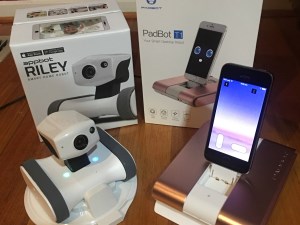Robotic technology and how we interact with it today is making a profound difference in people's lives – just ask Nicci Rossouw.
Nicci is passionate about providing technology that enables people to connect whenever and wherever they need to.
“I believe in a holistic approach as to how we reach our potential as human beings and our place in society, and one aspect of this is being connected to others,” she says.
And that’s where Telepresence Robots are now playing a key role.
Nicci is CEO and founder of Exaptec (Extreme Application Technology), a Melbourne based company specialising in social and service robotics – including telepresence devices.
Launched in 2015, Exaptec provides robots for “work and play” that can be used by businesses, individuals, teachers, students and families.
“A telepresence robot is basically a device that allows you to be somewhere where you can’t physically be,” explains Nicci. A camera, microphone and speakers are its eyes and ears.
“It can be linked to a smartphone, tablet or desktop – and via WiFi you can drive your robot around.”
And telepresence robots can be used for a broad variety of applications. They are now found in boardrooms, offices and conference centres throughout Australia.
“Whether it's a child that can't attend school because of illness or other reasons or someone with a disability being introduced into the workforce – or perhaps a parent on maternity or paternity leave who has to dial into a meeting.
“These are examples of where telepresence is being used today.”
Passion for robotics
Telepresence robots are especially useful if you need to attend a meeting or conference interstate or overseas and can’t find the time or you don’t have a big travel budget.
“For someone that travels between Melbourne and Sydney for meetings regularly, for instance, they basically pay for themselves immediately,” says Nicci.
And telepresence robots are ideal for children who are unable to attend school.
“At any given time, there are 60,000 students in Australia that are not at school due to illness or some other reason.
“I have one client in Melbourne whose child has leukaemia and cannot attend school.
“So he now can be taught via a telepresence robot. He attends as many lessons as he needs or is capable of attending on the day.
“This means he is connecting not only academically, but equally importantly connecting with his peers – and that social interaction with peers is vital.”
Surrounded by tech people
Nicci, who was born in South Africa and emigrated to Australia 20 years ago, has a passion and drive for robotics that is infectious.
“My interest in technology has grown over the last 5 years, especially how it’s augmenting our lives and how we connect with each other”.
To say Nicci has an active lifestyle is a gross understatement. She has no time to be idle.
A mother of two, Nicci had a successful career in sales and marketing in Johannesburg before moving to Australia with her husband, an IT specialist.
She works as a “wellness coach” once a week, particularly specialising with people with autism, the aged and those with disabilities.
She also likes to keep fit. While growing up in South Africa she was introduced to squash at an early age and is the current president of Squash and Racquetball Victoria.
Her first serious encounter with robotics was at the Dare Festival in Melbourne – an event which showcases innovative ways to advance workplace happiness to build more effective and agile organisations.
‘I saw an opportunity’
At that time Nicci was working for TABAR, a company which helps to organise the Festival.
“At the Dare Festival conference they were using a telepresence robot with great success. People from America and New Zealand were dialling in and engaging with the audience.
“I saw an opportunity … and Exaptec was born.”
Earlier this year, Exaptec was recognised as one on the “25 Most Promising Robotics and Automation Tech Solutions Providers in 2016” by APAC CIOoutlook.
The Exaptec robotics range is sourced mainly from the US, China and Korea.
It now includes telepresence robots such as the Beam Pro and Beam Plus, Double2, PadBot and Kubi, as well as Intelligent Service Robots – Sanbot and Amy, and Riley a mini Security Robot.
Visitors to the AUSPACK packaging show in Sydney earlier this year were greeted by Amy, a cute service robot supplied by Exaptec.
Amy assisted visitors in finding exhibitor stands, meeting rooms, eating and restroom facilities, shuttle bus pick-up points and times. And she provided timetables for educational and networking events.
Rise of the robots
“Robot technology is changing the way we work, learn and play, and are becoming an extension of our lives,” says Nicci.
And Australians can expect to see more robots in home and offices in the near future.
“I think service and social robots in particular will be used more in specialised areas such as for people with autism or mental disabilities – and our ever-increasing aging population.
“They will all need devices for social interaction – and in schools in the future it will be part of their life.”
Social and service robots will play a key role in aged care in coming years, Nicci predicts.
Ageing population
“In Japan, where there is a rapidly ageing population, these robots are being seriously utilised already.
“Aged care facilities are finding it increasingly difficult to get enough qualified staff members.
“There is definitely a demand for these services.”
Mobile robots are now being used in aged care facilities to transport medical supplies, lift patients out of beds and a robotics-based monitoring system with infrared sensors are being used to detect if patients are at risk of falling out of beds. And social robots are being used to interact with elderly patients.
Telepresence robots can also be used to monitor and interact with seniors in their homes.
“With a telepresence device you can drive it around in the home as a monitoring device”.
“These devices give older people or people with disabilities confined to their home a sense of autonomy – they can change people’s lives.”
They are also ideal for people living in remote areas, allowing them to be more creative and more connected with society.
Job losses
Nicci admits the “robotic revolution” will result in job losses in certain industries.
“But it will create new jobs as well,” she says. “But probably not as fast as it takes jobs, so there will be a slight disconnect until everything catches up.
“Some are predicting that in 120 years’ time robotic automation will be the norm in all industries.
“I don’t think robots will ever replace humans for all tasks – they cannot emulate our imagination or creativity. I can’t ever imagine a robot ever becoming an entrepreneur.
“But I do think we will co-exist with this new robotic technology – that will certainly happen.”
Nicci attributes Exaptec’s success to its consultative process with clients to make sure its robotic solutions fit the bill.
“Of course, customer service is extremely important to me,” she says.
Nicci says Exaptec is already the market leader in service robotic technology in Australia and predicts an enormous growth.
“Telecommunication robots have arrived and are here to stay.”


